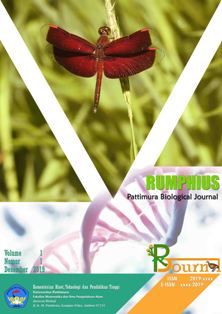THE EFFECT OF LONG BOIL BLACK CASSUM (Manihot aipiphol) ON THE PRESENCE OF BACTERIA
Abstract
Processing of black cassava has the possibility of microbial contamination because the fermentation process is carried out in the open, black cassava in the open, at room temperature, allowing microbes such as bacteria to grow. The aim of this research is to determine the length of time for boiling cassava and the presence of bacteria, and to determine the appropriate boiling time that can inhibit the presence of bacteria. From the results of observations of cassava samples containing bacteria before boiling, this shows that fresh cassava used as raw material naturally contains a number of bacteria. Observing the colony characteristics of all bacterial isolates counted and uncounted, it was found that there were similarities and differences in properties, where the results of the analysis showed that the long boiling time treatment had a great influence on the morphology of the bacteria, namely round and wrinkled, with smooth and grooved edges, raised elevations, flat and thick. The color of the bacteria on black cassava is the same, namely white, with treatment times of 10, 20, 30 minutes. The boiling time treatment has a very significant effect on the shape, edges and elevation in the presence of bacteria. The presence of bacteria in black cassava before boiling shows that it naturally contains a number of bacteria, with long boiling treatment the number of bacteria increases.
Downloads
References
Hermawan 2010. Brand Operations. Erlangga. Jakarta.
Mankiw, 2012. Introduction to Macroeconomics. Jakarta: Salemba Empat.
Mardikanto, 2009. Agricultural Extension Extension System. Eleven March University Press. Surakarta.
Nur. 2013. Fermentation Technology in Corn. Science House. Yogyakarta
Rangkuti. 2016. Techniques for Differentiating SWOT Analysis Business Cases. Jakarta: PT Gramedia
Sugiyono. 2009. Quantitative Qualitative Research Methods in R&D.Jakarta:Alfabeta
Sukirno. 2011. Introductory Macroeconomic Theory, Third Edition. Jakarta: Rajawali Press.
Sutanta. 2010. Factors causing the non-development of the Nguter Industrial Area, Sukaharjo Regency. Semarang: Undip
Valentine. 2009. Analysis of Cassava Chips Processing in Karanganyar Regency. Sebelas Maret University. Surakarta
Tri Radiyati and Agusto. 1990. Utilization of cassava. Subang: Research and Development Center for Applied Physics – LIPI. Page. 18 – 27.
Sticky. 1989. Rice Tape.In: Industry profile. Jakarta: Small Industry Guidance and Development Project, Ministry of Industry, s. a. Cassava Flour in: Food Industry Packages. Bogor: Center for Food Technology Development. IPB, Page 1.
Widianta and Widi. 2008. Cassava (mannihot esculenta) as an environmentally friendly alternative to gasoline (bioethanol). [connected periodically] www.scribd.com.
Haliza. ., Kailaku, and Yuliani. 2012. Use of mixture response surfae methodology in formula optimization brownies based on Banten taro flour (Xanthosoma Undipes K. Koch) as an alternative food source of fiber. Postharvest Journal. Vol. 9 (2): 96-106.
Harnanik, S. 2014. Performance of technology adoption in the implementation of M-KRPL in three locations in Prabumulih City. Seminar Proceedings National Suboptimal Land 2014. Palembang 26-27 September 2014. Pages 143-1 to 143-8.
Harwanti. Zubaidi., and Antarline. 2011. Purple sweet potato as a raw material for making ice cream. Seminar Proceedings National 2nd National Conference on Green Technology-Eco Technology for Sustainable Living. Pages G-128 to G133. Malang, November 12 2011.
Hersoelistyorini, W., Dewi, and A.C. Kumoro. 2015. Physicochemical and organoleptic properties of mocaf flour (Modified Cassava Flour) by fermentation using cabbage extract. The 2nd University Research Coloquium. ISSN 2407-9189. Pages 10-17.
Jusuf, M., Rahayuningsih, and Ginting, E. 2008. Purple sweet potato. Agricultural Research and Development News. 30: 13-14.
Kasno. N., Saleh. E. Ginting. 2006. Development of food based on nuts and useful tubers
strengthening national food security. Research Institute for Legumes and Tuber Crops. Bul. Palawija No. 12: 43-53.
Authors who propose a manuscript and have it approved for publication know that the manuscript will be registered and become part of the RPBJ. Authors and readers understand that this journal is open and all its contents can be accessed freely, provided that RPBJ is still listed as the source of information. The hope is that this journal can become a vehicle for exchange and scientific knowledge for society and the scientific community, especially in the field of Biology and other branches of science.









